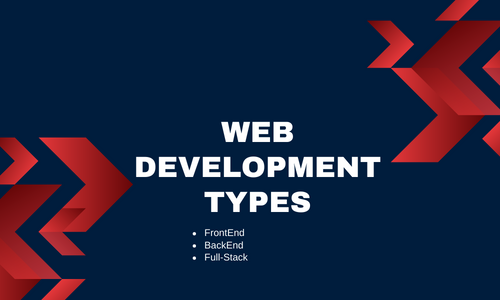Whenever website users press the “Pay Now” button, they seldom think of the hidden code that leads them to a payment section on the webpage. It is largely the responsibility of web designers to design such buttons. They should also foreground the options and logic that impel the website. Different types of web development have been discussed below:
Content
- What is web development?
- What are the different types of web development processes?
- Which Are the Languages Used in The Front-End Development?
- Which Are the Languages Used by Back-End web Developers?
- Conclusion
What is web development?
Web development is a subfield of computer science. Web developers work with IT professionals, marketing team experts, and other such departments to design a creative and excellent website that keeps the customers engaged and helps increase sales growth.
What are the different types of web development processes?
There are three types of web development, and all types contribute to a better user experience. Knowing their definition and usage is important for a better understanding of their development tools.
1. Front-End Web Development
Front-end technologies like CSS, JavaScript, and HTML design the website. This web development aims to make the content more accessible for people to read. Web developers have to write clean and simple code for Front-End Web development. This type of web development is also called client-side web development.
The front-end developer is responsible entirely for designing a better look and creating the overall interactive interface of the website. The front-end developer is responsible for all the colors, fonts, images, and overall look of the website viewed by the users on their phones, tablets or laptops, etc.
The front-end developer has to ensure the website’s overall look. He has to create different templates for people’s ease with phone, tablet, and desktop screens.
2. BackEnd Developers
The backEnd web development involves all the back-end maintenance work. The website operates because of the endless efforts of the back-end developer. The back-end developer is responsible for writing down the website code, which provides the logic for executing tasks and maintaining the overall website.
The code connects the website with the server and ensures the proper flow of data. The back-end developer writes and manages the code to run the website smoothly. The common languages used by back-end developers are Java, PHP, MySQL, Golang, and Python.
The back-end developer is considered the most important person who handles the most crucial aspect of web designing. The back-end developer manages the database and makes the possible changes, which are then shown on the screen for the users.
3. The Full-Stack Developer
The Full-Stack Developer is an all-rounder who works at the front and back end and is responsible for full-stack web development. A full-stack web designer must be well-versed in building, speeding up, designing, and developing a website. The full-stack developer needs to know about web design, web development, web database, and debugging. A full-stack developer should have the expertise to manage the overall website.
A full-stack developer has to manage everything from the server to the user end. The full-stack developer also manages the website’s capabilities and overall speed. The full-stack developer with knowledge of the front and back end is rarely found. The diverse experience of a full stack developer helps in the speeding process of web development, and also, they are experts in troubleshooting problems.
Which Are the Languages Used in The Front-End Development?
The three most important and widely used languages in front-end development are JavaScript, CSS, and HTML. They play a pivotal role in web development, especially in front-end development. These three languages are comparatively easier to learn, hugely facilitating the developers, and offer plenty of creativity. To become a master of front-end development, you must master these three languages and JavaScript frameworks.
Which Are the Languages Used by Back-End web Developers?
Python, PHP, Net, Ruby, JavaScript, Rust, Kotlin, SQL, .Net, Angular, and Go are frequently used back-end languages. Such back-end programming languages outline the framework that demystifies the process of web development. Some pivotal tools exploited in back-end development are databases, operating systems, servers, communication protocols, and software stacks.
Conclusion
Knowing the art of web development and its different kinds and languages can hugely streamline our business by beautifully shaping our websites. Carving out amazing websites and keeping them active and alive can be possible if we have good knowledge of web development and its kinds at our disposal. Learning the art of crafting the perfect websites and platforms needs formal knowledge, rigorous practice, and hard work. Once you have achieved these things, you are ready to flourish your business.
Related Articles:







